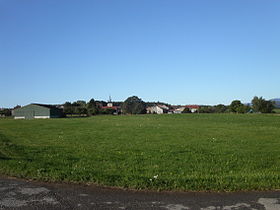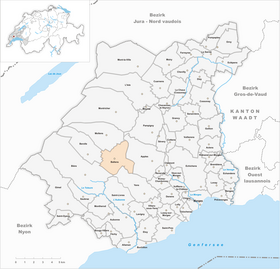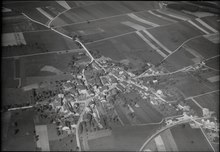Bale
| Bale | |
|---|---|
| State : |
|
| Canton : |
|
| District : | Morges |
| BFS no. : | 5423 |
| Postal code : | 1144 |
| Coordinates : | 518 391 / 156 462 |
| Height : | 707 m above sea level M. |
| Height range : | 662–730 m above sea level M. |
| Area : | 8.45 km² |
| Residents: | 537 (December 31, 2018) |
| Population density : | 64 inhabitants per km² |
| Website: | www.ballens.ch |
|
Bale seen from the north |
|
| Location of the municipality | |
Ballens is a municipality in the Morges district in the canton of Vaud in Switzerland .
geography
Ballens is located at 707 m above sea level. M. , 11 km northwest of the district capital Morges (air line). The clustered village extends on a hilltop on the high plateau at the foot of the Jura , in the Vaudois Central Plateau .
The area of the 8.5 km² municipal area comprises a slightly undulating section in the western edge of the central plateau. The communal soil extends from the Jura foot eastward over the Veyron valley and the ridge from Ballens to the dry valley of Grand Marais in the east. This flat valley, up to 300 m wide, was once used as a meltwater channel on the edge of the Ice Age Rhone glacier . In the south the area extends into the forest Le Sépey , in which at 729 m above sea level. M. the highest elevation of bale is reached. In the far south-east part of the forest of Les Bougeries (up to 704 m above sea level ) belongs to Ballens. In 1997, 5% of the municipal area was in settlements, 30% in forests and woodlands, 64% in agriculture and a little less than 1% was unproductive land.
The hamlet of Froideville ( 685 m above sea level ) on the western edge of the Grand Marais valley and a few individual farms belong to Ballens . The neighboring communities of Ballens are Bière in the southwest , Berolle in the west , Mollens in the north, Apple in the east and Yen in the south .
population
With 537 inhabitants (as of December 31, 2018), Ballens is one of the small communities in the canton of Vaud. 88.0% of the residents are French-speaking, 5.6% German-speaking and 5.0% Portuguese-speaking (as of 2000). The population of Ballens was 422 in 1850 and 361 in 1900. Since then it has been commuting between 350 and 400 inhabitants.
economy
Up until the middle of the 20th century, Ballens was a predominantly agricultural village. Agriculture still plays an important role as a livelihood for the population. It focuses on agriculture and animal husbandry and dairy farming . Thanks to the good transport links, several construction companies, a forge and a bookbindery have settled in Ballens. There are other jobs in the service sector.
traffic
The community has good transport connections. It is located on the main road from Morges to Bière . On July 1, 1895, the Bière – Apples – Morges narrow-gauge railway with a station in Ballens was put into operation.
history
A barrow from the Hallstatt period was found near Ballens . The first documentary mention was made in 1139 under the name Barlens , in 1453 the spelling Balens appeared . In the Middle Ages, Ballens was the center of a small dominion that was under the Romainmôtier monastery and the lords of Aubonne . Since the conquest of Vaud by Bern in 1536, Ballens shared the fortunes of Aubonne and in 1701 came to the Aubonne Bailiwick. After the collapse of the Ancien Régime , the village belonged to the canton of Léman from 1798 to 1803 during the Helvetic Republic, which then became part of the canton of Vaud when the mediation constitution came into force . In 1798 Ballens was first assigned to the Morges district, in 1803 it came to the Aubonne district.
Attractions
The Saint-Maurice church was mentioned as early as 1139. The building has been redesigned several times, the bell tower dates from 1715. In the old town center, characteristic farmhouses from the 16th to 19th centuries have been preserved.
Web links
- Official website of the municipality of Ballens (French)
- Frédéric Besson: Ballens. In: Historical Lexicon of Switzerland .
- Aerial photography
Individual evidence
- ↑ Permanent and non-permanent resident population by year, canton, district, municipality, population type and gender (permanent resident population). In: bfs. admin.ch . Federal Statistical Office (FSO), August 31, 2019, accessed on December 22, 2019 .




